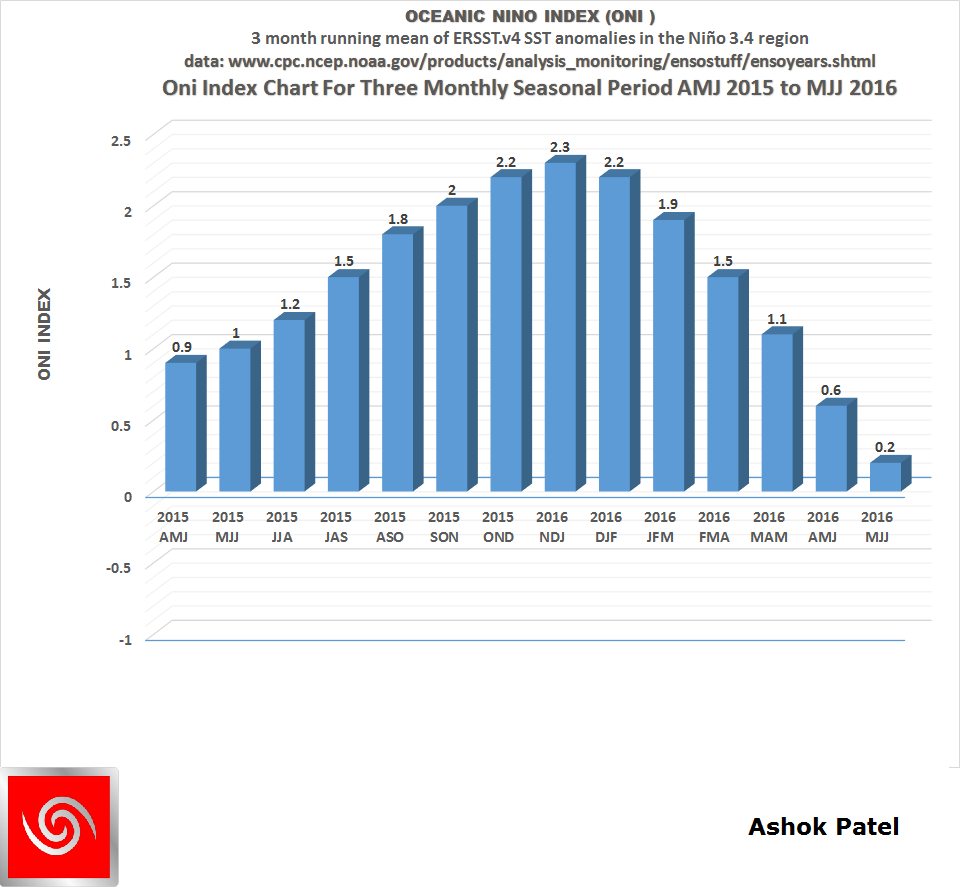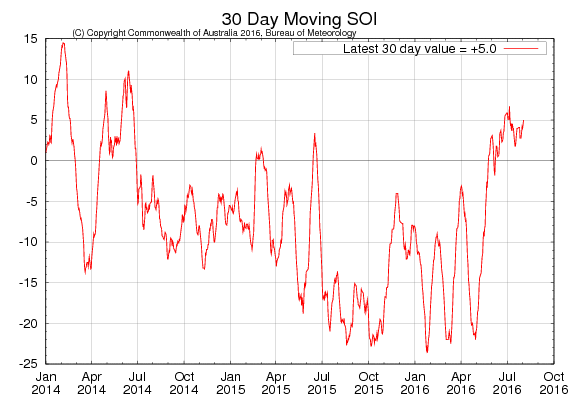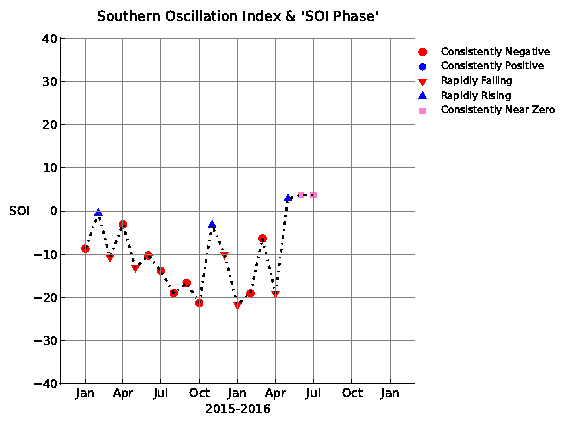El Nino Status on 5th August 2016
The ONI is based on SST departures from average in the Niño 3.4 region, and is a principal measure for monitoring, assessing, and predicting ENSO. Defined as the three-month running-mean SST departures in the Niño 3.4 region. Departures are based on a set of improved homogeneous historical SST analyses (Extended Reconstructed SST – ERSST.v4). The SST reconstruction methodology is described in Huang et al., 2015, J. Climate, vol. 28, 911-930).
CPC uses current Climatology based on 1981-2010 which should have been changed to base years 1986-2015 as has been mentioned by them in their explanation about Climatology base years change here.
NOAA Operational Definitions for El Niño and La Niña El Niño: characterized by a positive ONI greater than or equal to +0.5ºC. La Niña: characterized by a negative ONI less than or equal to -0.5ºC. By historical standards, to be classified as a full-fledged El Niño or La Niña episode, these thresholds must be exceeded for a period of at least 5 consecutive overlapping 3-month seasons.
CPC considers El Niño or La Niña conditions to occur when the monthly Niño3.4 OISST departures meet or exceed +/- 0.5ºC along with consistent atmospheric features. These anomalies must also be forecast to persist for 3 consecutive months.
The current El Nino event was confirmed at the end of August 2015 considering the SST departures from average in the Niño 3.4 region based on Extended Reconstructed SST – (ERSST.v4). The graph below shows that at the end of July El Nino is officially over. ENSO neutral conditions started end of July 2016, the last available 3 monthly season being MJJ 2016. Considering the official NOAA definition for La Nina, technically it is not possible to have a full fledged La Nina during the 2016 Indian Monsoon season. If the August SST anomaly for Nino 3.4 region is above -1.0ºC then technically a full fledged La Nina is not even possible during the year 2016, because there will be just four 3-monthly seasons left after August.
જુલાઈ 2016 આખર થી ‘એલ નિનો’ ખતમ થયો. હાલ ‘એન્સો ન્યુટ્રલ’ પોઝિશન છે. 2016 ના ભારતીય દક્ષિણ પશ્ચિમ ચોમાસા દરમિયાન ‘લા નીના’ પ્રસ્થાપિત નહિ થાય. તેવીજ રીતે ઓગસ્ટ માં જો નિનો 3.4 SST -1.0 C થી ઊંચું હશે ટો 2016 માં પણ ‘લા નીના’ શક્ય નહિ બને.
Latest Oceanic Nino Index (ONI) Graph till July 2016
The Table below shows the monthly SST of Nino3.4 Region and the Climate adjusted normal SST and SST anomaly for last two years.
Period Nino3.4 ClimAdjust YR MON Temp.ºC Temp.ºC ANOM ºC 2014 7 27.28 27.31 -0.02 2014 8 26.90 26.96 -0.06 2014 9 27.03 26.87 0.16 2014 10 27.25 26.83 0.42 2014 11 27.51 26.78 0.74 2014 12 27.40 26.73 0.68 2015 1 27.22 26.71 0.51 2015 2 27.25 26.89 0.36 2015 3 27.79 27.37 0.42 2015 4 28.59 27.85 0.73 2015 5 28.83 27.96 0.87 2015 6 28.70 27.73 0.97 2015 7 28.50 27.31 1.20 2015 8 28.47 26.96 1.51 2015 9 28.62 26.87 1.75 2015 10 28.86 26.83 2.03 2015 11 29.14 26.78 2.36 2015 12 29.04 26.73 2.31 2016 1 28.94 26.71 2.23 2016 2 28.89 26.89 2.01 2016 3 28.87 27.37 1.50 2016 4 28.97 27.85 1.12 2016 5 28.61 27.96 0.64 2016 6 27.84 27.73 0.11 2016 7 27.10 27.31 -0.21
May, June & July 2016 SST anomaly for Nino3.4 region is used to calculate the latest ONI Index for MJJ 2016 as +0.2ºC. Since the latest ONI Index is below +0.5ºC and above -0.5ºC, ENSO neutral condition has set in at the end of July 2016.
CPC considers El Niño or La Niña conditions to occur when the monthly Niño3.4 OISST departures meet or exceed +/- 0.5°C along with consistent atmospheric features. These anomalies must also be forecast to persist for 3 consecutive months.
Southern Oscillation Index
As per BOM, Australia: The latest 30-day Southern Oscillation Index (SOI) up to 31 July 2016 is +4.2, which is well within the neutral ENSO range. The 30-day SOI has remained within the neutral range during the past month. Latest 30-day SOI is +5.0 on 3rd August 2016.
Sustained positive values of the SOI above +7 may indicate La Niña, while sustained negative values below −7 may indicate El Niño. Values of between about +7 and −7 generally indicate neutral conditions.
SOI Monthly graph up to July 2016 as per The Long Paddock – Queensland Government.
SOI was +3.70 at the end of July 2016 as per The Long Paddock – Queensland Government.
Summary by: Climate Prediction Center / NCEP Dated 1st August 2016
ENSO Alert System Status: La Niña Watch ENSO-neutral conditions are present.* Equatorial sea surface temperatures (SST) are near or below average in the east-central and eastern Pacific Ocean. La Niña is favored to develop during August-October (ASO)2016, with about a 55-60% chance of La Niña during the fall and winter 2016-17.*
* Note: These statements are updated once a month (2nd Thursday of each month) in association with the ENSO Diagnostics Discussion, which can be found by clicking here
As per BOM -Australia 2nd August 2016
La Niña WATCH remains, while strong negative Indian Ocean Dipole continues
Despite some cooling of the tropical Pacific Ocean surface waters, ENSO indicators remain neutral and well shy of La Niña thresholds. In contrast, a strong negative Indian Ocean Dipole (IOD) event continues, with ocean temperature well above average in the eastern Indian Ocean and below average near Africa.


